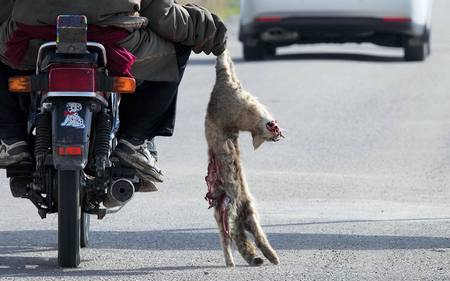Dead yak in the middle of the road
As the sun sank on a cold windswept September evening, a Himalayan marmot was waddling as fast as it could across National Highway 213 in Sichuan Province, presumably to join its home colony across the busy road. It never made it. A truck sped by and smashed it.
 |
|
A motorist picks up a Chinese desert cat killed on the road. Photo: Courtesy of Chengdu Bird Watching Society. |
Earlier that day, a Tibetan mastiff was crossing the same highway and met an identical untimely end, becoming roadkill after a car struck it and kept going.
They were only two of perhaps hundreds of animals - ranging from birds and frogs to yaks, wild dogs and sheep - killed daily on the 2,827 kilometer long highway that runs through Sichuan, Yunnan and Gansu provinces.
In a 2009 report by artsma.com, China's first online auto sales platform, Highway 213 was listed as one of China's 10 most dangerous roads for drivers.
And according to a roadkill report conducted by World Wildlife Fund in 2007, an estimated 5,800 animals were smashed to their deaths in northern Sichuan's Ruo'ergai wetland-prairie area alone. Ruo'ergai is surrounded by three highways including Highway 213.
But there are no official statistics about how many people die or are injured in smashups with animals. Ruo'ergai is home to 40 bird species and more than 100 animal species, all defenseless against the force of vehicular horsepower.
Though China has no animal protection laws, volunteers such as Shen You, 36, and seven other members of the Chengdu Bird Watching Society are on a mission to protect both animals and humans who hit them.
That's why nearly every month, they drive about 600 kilometers from Chengdu, capital of Sichuan, to Ruo'ergai to collect and record roadkill data.
They made a week long field study to Ruo'ergai in late September to count the number of wildlife passageways across roads, record speeds of vehicles and map roadkill hotspots.
 0
0 







Go to Forum >>0 Comments